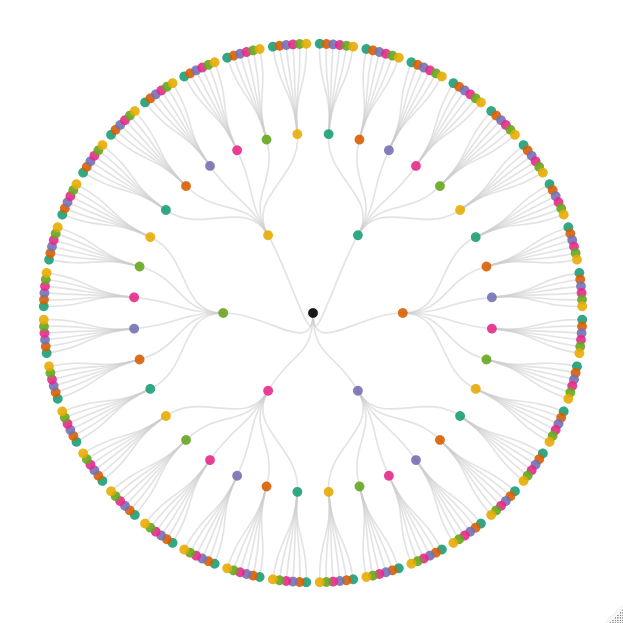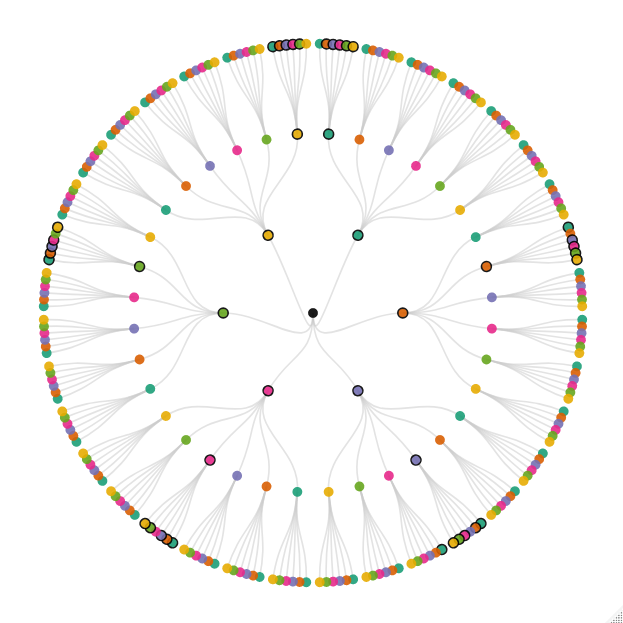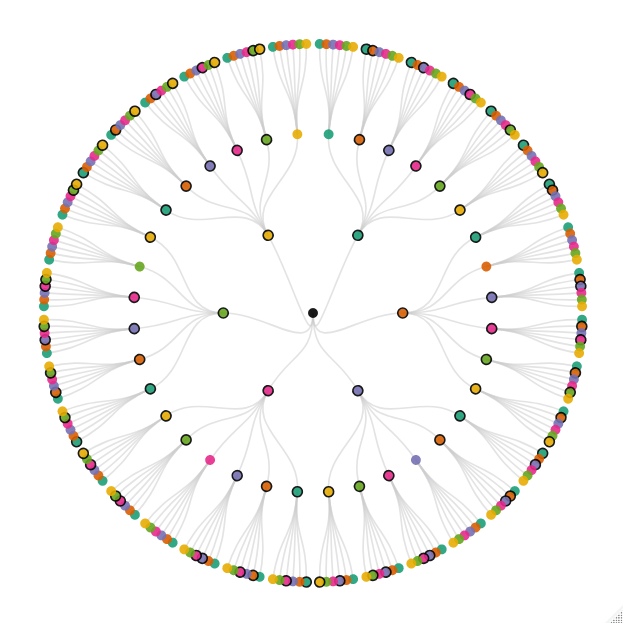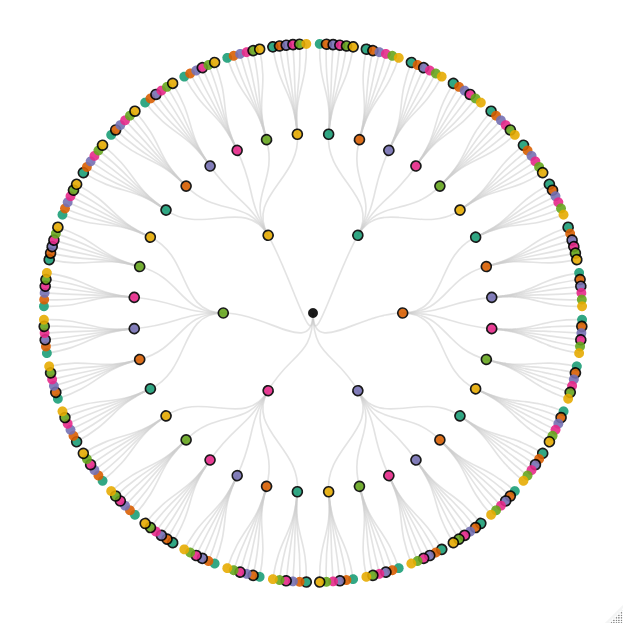Probability of only a pair with n dice #
A pair is two dice that show the same number. Here we calculate the probability of rolling a pair, and only a pair, when n dice are rolled. By “only a pair”, we mean all the other dice are different and therefore there are no three-of-a-kinds, no four-of-a-kinds, not two pairs, etc. The roll contains one pair, and all the other dice have different numbers showing.
To calculate the probability of only one pair and nothing better when a certain number, n, dice are rolled, one must count the number of ways that a pair can be rolled and that all other dice are different. Then divide this number by the total number of possible rolls with that number of dice.
If you’d like the general formula skip to here: General formula for probability of only a pair with any number of dice
docs/probability/onlyPairDice/#general-formula-for-probaility-of-only-a-pair-with-n-dice
Probability of a pair when rolling one die, n=1 #
When one die is rolled the probability of a pair is zero. It’s good to get the easy ones out of the way early.
Probability of a pair when rolling two dice, n=2 #
1/6 is the probability of rolling a pair with two dice.
When 2 dice are rolled there are 36 possible outcomes. For each of the 6 numbers that the first die can take, there are six numbers that the second die can take. This means there are \(6 \times 6 = 6^2 = 36 \) possible rolls. The table below shows all those possible rolls with two dice. Pairs are bolded.
| die 1 \ die 2 | 1 | 2 | 3 | 4 | 5 | 6 |
|---|---|---|---|---|---|---|
| 1 | 1,1 | 1,2 | 1,3 | 1,4 | 1,5 | 1,6 |
| 2 | 2,1 | 2,2 | 2,3 | 2,4 | 2,5 | 2,6 |
| 3 | 3,1 | 3,2 | 3,3 | 3,4 | 3,5 | 3,6 |
| 4 | 4,1 | 4,2 | 4,3 | 4,4 | 4,5 | 4,6 |
| 5 | 5,1 | 5,2 | 5,3 | 5,4 | 5,5 | 5,6 |
| 6 | 6,1 | 6,2 | 6,3 | 6,4 | 6,5 | 6,6 |
Another way to visualize this is with a tree:

Paths of Two Dice Rolls
The inner ring are the possible values the first roll could take, 1 through 6. Then for each of the possible values the first roll can have, there are 6 possible value for the second roll, the outer ring. There are a total of 36 paths possible corresponding to the 36 possible rolls with 2 dice. A pair is two dice with the same value, and you can see looking at the paths that there are a total of 6 paths with two rolls the same number (same color in the figure).
Thus we see when two dice are rolled there are 6 possible pairs that could arise: 1,1; 2,2; 3,3; 4,4; 5,5; 6,6. Therefore, the probability of rolling a pair with two dice is one sixth or about 16.7%. \(\frac{6}{36} = \frac{1}{6} = 0.166666 \approx 16.7\% \)
Probability of only a pair when rolling three dice, n=3 #
With three dice rolled, there are 216 possible outcomes. \( 6 \times 6 \times 6 = 6^3 = 216 \) . The reasoning for the number of possible rolls is the same as with two dice but extended to three: the first die can take one of six options, the second die can also take one of six options, and so can the third. You can imagine the table above with 36 possible options for two dice being multiplied by 6 since there are six options for the third die for each of the 36 options for the first two dice. Such a table is hard to make legibile on a single page, but it’s possible to visualize the 216 possible outcomes as branching paths. Here we’ve kept the same color scheme as above, but suppressed the numbers to prevent over plotting:

Each path represents one possible roll. A pair is any path that contains two dots of the same color (indicating the dice showed the same number) and one dot of a different color. If all three dots are the same color, that’s a three-of-a-kind which is considered “more than” just a pair. At the moment we are interested in the probability of only a pair (and nothing better). To find this probability, we need to count the number of paths with only two dots the same color and then divide this by 216, the total number of possible rolls. One way to intuitively do this is to count pairs that arise in the first two rolls and then count pairs that arise in the second two rolls.
Ways to get a pair by the second roll #

The above figure represents the 6 * 1 * 5 = 30 ways to get a pair in the first two rolls. To get a pair in the first two rolls, it does not matter what the first roll is - you can always get a pair regardless of which number appears on the first die - so all 6 of the first dots are circled black. For the second roll to make a pair in the first two rolls, it must match the first. So while there are six options for the first die, there is only one option for each of the first die. For the third roll, it must be different from the first two rolls. So if I roll a “1” on the first die and a “1” on the second die, the third die must be either “2”, “3”, “4”, “5”, or “6”. So once a pair is achieved in the first two rolls, the third roll has 5 possibiliites. As a consequence, there are 6 * 1 * 5 = 30 pairs that can arise on the first two rolls. The paths with dots circled black indicate all such paths.
Ways to get a pair on the third roll #

To get a pair with the third roll, the first two rolls cannot be a pair. The first roll can be any of the 6 possible numbers, but the second cannot match the first. Then the third roll must match either the first roll or whatever the second roll is. The paths with dots circled black indicate all such paths. There are 6 * 5 * 2 = 60 of these paths and so 60 ways to get a pair with the third roll.
All ways to get a pair with 3 dice rolls #

In total there are 90 ways to get only a pair with 3 rolls.
\[6 * 1 * 5 + 6 * 5 * 2 = 90\]Thus the probability of rolling only a pair with 3 dice is 90 / 216 = .41667 = 41.667%.
Probability of only a pair when rolling four dice, n=4 #

1296 Paths of Four Dice Rolls
With four dice there are 6 * 6 * 6 * 6 = 6^4 = 1296 possible rolls. Listing these out is certainly possible, but not easy to read and the branching paths diagram is starting to get quite unwieldy. We will have to start applying understanding gained in simplier cases to the harder to visualize cases.
Counting ways to get pair on each roll #
One way to count the number of ways to get a pair is to count the ways to get a pair on the second roll, the ways to get a pair on the third roll and the ways to get a pair on the fourth roll; and then add all of these up.
To get a pair on the second roll (and not on any of the subsequent rolls), the first die can be any number so there are six options. The second die must match the first, so for each of the 6 first rolls there is one option on the second roll. The third roll cannot match the number that was paired in the first two rolls, so there are 5 possible options for the third roll. The fourth roll cannot match the number that was paired on the first two rolls nor the number that showed on the third roll, so there are four options for the fourth roll. So the number of ways to get a pair on the second rolls is 6 * 1 * 5 * 4 = 120.
To get a pair on the third roll, the first die can be any number (6 options), the second die cannot pair with the first die (5 options), the third die makes the pair so it pairs with either the first or second die (2 options), the fourth die cannot match any of the other die (4 options). So the number of ways to get a pair on the third roll is 6 * 5 * 2 * 4 = 240.
To get a pair on the fourth roll, the first die can be any number (6 options), the second die cannot pair with the first die (5 options for each of the first 6 options), the third die cannot pair with either the first or the second die (4 options for each of the 6 * 5 = 30 possible non pairing first two rolls), and the fourth die must pair with one of the three numbers in the first three rolls (3 options for each of the 6 * 5 * 4 = 120 non pairing first three rolls).
Adding all of these ways to roll only a pair there are a total of:
\[6 \times 1 \times 5 \times 4 + 6 \times 5 \times 2 \times 4 + 6 \times 5 \times 4 \times 3 = \\ (1 + 2 + 3) \times 6 \times 5 \times 4 =\\ 720\]A shorter way #
Rather than counting all the ways to get a pair by counting the ways to get a pair on each roll and then adding all them up, it is faster to consider the problem in a different way.
Imagine we rolled a pair of 2’s, a 4 and a 5. There are 12 ways that this set of numbers can arise:
| 2245 | 2254 |
| 2425 | 2524 |
| 2452 | 2542 |
| 4225 | 5224 |
| 4252 | 5242 |
| 4522 | 5422 |
If 4 was paired instead of 2, the possible rolls would be:
| 4425 | 4452 |
| 4245 | 4542 |
| 4254 | 4524 |
| 2445 | 5442 |
| 2454 | 5424 |
| 2544 | 5244 |
If 5 was paired instead, the possible rolls would be:
| 5524 | 5542 |
| 5254 | 5452 |
| 5245 | 5425 |
| 2554 | 4552 |
| 2545 | 4525 |
| 2455 | 4255 |
If we use letters to indicate the two paired numbers (call them X and X) and the two unpaired numbers (call them Y and Z), we can see that with 4 dice containing 1 pair the rolls always follow one of the following 12 patterns:
| XXZY | XXYZ | ZZXY | ZZYX | YYXZ | YYZX |
| XYXZ | XZXY | ZYZX | ZXZY | YXYZ | YZYX |
| XYZX | XZYX | ZYXZ | ZXYZ | YXZY | YZXY |
| YXXZ | ZXXY | YZZX | XZZY | XYYZ | ZYYX |
| YXZX | ZXYX | YZXZ | XZYZ | XYZY | ZYXY |
| YZXX | ZYXX | YXZZ | XYZZ | XZYY | ZXYY |
Where X, Y, and Z are each one of the 6 numbers on a die.
So for any 3 numbers that are in a roll of 4 with a pair, there are 6 * 6 = 36 ways that they can be arranged.
So for each of the sets of 3 numbers in a roll of 4 with a single pair, there are 36 ways to arrange the 3 numbers amongst the 4 dice.
Next we need to count the number of ways we can pick 3 numbers to assign to X, Y, and Z from the 6 faces of a standard die. There are \( {6 \choose 3} = 20 \) ways. \[{6 \choose 3} = \frac{6!}{3!3!} = \frac{6 \cdot 5 \cdot 4 \cdot 3 \cdot 2 \cdot 1}{3 \cdot 2 \cdot 1 \cdot 3 \cdot 2 \cdot 1} = \frac{6 \cdot 5 \cdot 4}{3 \cdot 2 \cdot 1} = 5 \cdot 4 = 20\]
Multiplying the number of ways to select 3 numbers from the 6 possible (20) by the number of ways to arrange the 3 numbers among the 4 dice (36), we find there are 20 * 36 = 720 ways to get only one pair with 4 dice.
The probability of getting only a pair with four dice is therefore 720/1296 = .55556 = 55.556%.
Probability of only a pair when rolling five dice, n=5 #
Probability of only a pair when rolling six dice, n=6 #
General formula for probaility of only a pair with n dice #
thinking about “order”. I often used order above saying “first” and “second”, but you could also just think of these as “die 1” and “die 2”. expand on this thought a bit more.